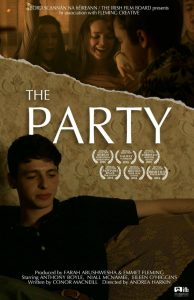
Cast: Niall McNamee, Anthony Boyle, Eileen O’Higgins, Ross Mckinney, Tara Cush
Director: Andrea Harkin
Studio: Fleming Creative
Distributor: The Irish Film Board
Genre: Short, Drama, War
Review Spoilers: Moderate
I am no history buff. In fact, I’m the complete opposite. I understand that history is enormously important and it is necessary not only to record it, but also to study it. But, come on son! It’s all dry, drier than a sandwich without mayonnaise. I’d typically rather lay down in front of a lawn mower than ingest history in most forms. The only form in which I would willingly consume history is in television and film but, understand this, I would not seek it out. I would only be more open to viewing it. There are still loads of television series and films that I avoid simply because the way that they present the historical information is of no interest to me.
The Party is not one of those films. Within the first few seconds, I found myself engaged and interested in seeing more. This film is one of few that was so interesting that it made me look outside of the film for the history behind it. From the very opening, the film displays a claustrophobic, tense atmosphere in the subtlest of details. It’s all in the details and in this case, they are handled beautifully.
The Party tells the story of a very young man returning home after some time away and being welcomed with a small party thrown by his cousin’s close friends. Of course there is always more to a story and this particular story roots itself in grim context. The protagonist, Micky, is a member of the IRA, the Provisional Irish Republican Army, a republican paramilitary organization that fought for Northern Ireland’s independence from British rule in the mid-late 1900’s.
After being on the run for so long, Mickey returns home to visit his cousin, Laurence, who organizes the small gathering. The mood is tense, the exact opposite of what a party should be. Before long, the party becomes a lot less fun and a lot more fatal.
What it did right: Structure, providing context with subtle details, using contrast between characters to deliver messages.
Someone close to me once said, “That’s the point of a short film: to make you want more.” While I had not realized the significance of this until they enlightened me, upon first hearing, its truth struck me without delay. Not only is this true for cinematic content in any regard, but it is especially true for short films. To make me not only want more of the film, but also to desire more knowledge of the events the film revolves around is an amazing feat of narrative proportions.
For this short, its neat structure made the film very easy to watch. Put more precisely, the film knew where to start and where to end for maximum meaning. This should be expected of a film in general, especially a short one, but I’ve seen many that dawdled without purpose.
As for the context the film provides, it does so in a manner that presents itself more realistically as background information you’d naturally pick up on instead of a history lesson rammed down your throat. Following the film’s start, I witnessed a man using a particularly deceptive disguise to sneak past troops. In a flowery dress and wig, he had us both fooled. One of the most humorous moments of the film, it also served to show how extreme the situation was. The history behind the film is extensive, but very eventful. So to you Google, old friend, I say let’s take a trip neither of us is accustomed to taking together.
After the separation of Ireland into a Catholic Irish Free State and Protestant Northern Ireland, the IRA emerged in 1969 and committed several terrorist acts. On July 21st of 1972, a day that later became known as “Bloody Friday,” the IRA exploded 19 bombs around Belfast in less than an hour. Nine individuals were killed and 130 were injured. This caused the British government to enact “Operation Motorman,” an operation that resulted in large scale occupation of Northern Ireland by British forces. During the aftermath, several selective search, arrest, and surveillance measures took place. These measures are what the film mainly refers to, although this is only a peek at the full background.
The characters within the film are also used as a narrative tool for showing the impacts of war, occupation, and the IRA’s actions. The Party indicates the differences between Mickey, changed by the attacks he has taken part in as a member of the IRA, and his friends, oblivious while full of blissful ignorance. Throughout most of the party, Mickey’s mind is elsewhere and his serious demeanor stands out in the party’s nonchalant atmosphere. Of course, they all face harrowing consequences and no one is left untouched by horror.
What it did wrong: Not much.
I’m sure the film was not perfect, but I am hard pressed to find even a scintilla of error. Any small detail that comes to mind seems more like a preference than a narrative absolute. Consider how that may say even more than any praise I could muster.
Final Thoughts: The film was engaging and informative. It introduced characters in interesting ways, that definitely drew my attention. It’s easy to see that every decision was made with intention and great purpose, so each one of them paid off. Not only did it leave me wanting more of the film, but it also developed within me an interest in the history behind the film.
Have any questions? Is there anything you’d like to say? Leave a comment and let us know. We’d love to hear it.